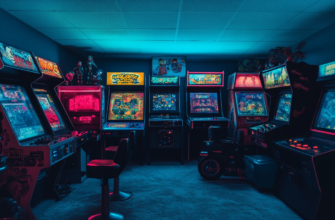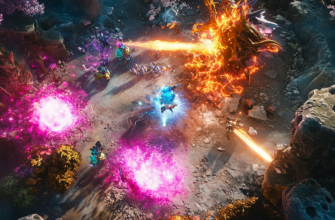Yo, gamers! You know that feeling when an epic piece of loot drops in the middle of an adrenaline-packed moment? Whether you’re deep in a mystical RPG or on the frontlines of an intense shooter, we all live for that one amazing drop that changes the game. But have you ever stopped to think about how loot defines your experience in these games? Why are we so drawn to loot systems, and what makes them work so well in modern RPGs and shooters?
- Why loot matters in gaming
- Terminology you should know
- The evolution of loot systems in RPGs
- How modern RPGs use loot
- Loot systems in shooters
- What makes loot in shooters different?
- Step-by-step guide to mastering loot systems
- Best loot-based games to sink your teeth into
- Conclusion: Loot — the backbone of modern gameplay
Why loot matters in gaming
In both RPGs and shooters, loot plays a critical role in shaping the player’s experience. It’s the reward that keeps us coming back for more, constantly pushing us to explore, fight, and survive for that next upgrade or shiny treasure.
Loot systems have become an essential mechanic driving player progression, giving us objectives to chase and keeping us engaged in both single-player campaigns and multiplayer mayhem. In today’s gaming landscape, loot isn’t just a bonus — it’s often the entire point of the grind. The right loot can make even the most basic enemies thrilling to fight, knowing that at any moment, a rare item could change everything.
Terminology you should know
- Loot table: A database that determines what items enemies or chests can drop. It’s essentially a virtual “list” that the game uses to decide what loot you receive after a kill.
- Drop rate: The percentage chance of receiving specific loot. The rarer the gear or item, the lower this number tends to be.
- Epic/Legendary gear: Items that are typically rare and have special attributes or powers compared to standard or “common” loot.
- Grind: The repetitive task of farming enemies or missions to accumulate loot and experience. All about that slow progress, baby!
The evolution of loot systems in RPGs
In RPGs (Role-Playing Games), loot is often directly tied to your character’s power progression. Remember running around in classic MMORPGs looking for that one rare sword to make you OP? Yeah, those were the days. Today’s loot systems have evolved to be even more immersive, incorporating dynamically generated gear, customization options, and tier-based rarity systems.
How modern RPGs use loot
Modern RPGs are all about variety and depth when it comes to loot. The days of simple weapon upgrades are long behind us. Now, loot can influence everything from your character’s combat abilities to their very playstyle.
Here’s how loot works in today’s RPGs:
- Tiers of rarity: You know the drill — white (common), green (uncommon), blue (rare), purple (epic), orange (legendary). The color-coding system makes it easy to spot the good stuff at a glance.
- Stat rolls: Many modern RPGs, like Diablo III or Path of Exile, use stat variations in loot, so even if you get the same weapon twice, the actual stats may be different. This keeps players hunting for “perfect rolls” — the version of an item with the best attributes.
- Customization: The latest trend in loot is fully customizable gear. Titles like Cyberpunk 2077 let you modify weapons or armor to match your playstyle or aesthetic preferences.
- Loot as storytelling: Some games enrich the narrative through their loot system. Think about unique items that come with backstories or lore-laden artifacts in games like The Witcher 3. These can enhance immersion while giving you cool gear.
Loot systems in shooters
At first glance, shooters might seem like they’d have less use for loot, as weapon variety is often based on real-world firearms. But, looter-shooters like Destiny 2 or Borderlands blend RPG mechanics into the shooting genre, integrating loot in meaningful ways that go beyond just swapping guns. In fact, loot plays a huge role in these games, offering incentives designed to make every firefight just a little more exciting.
What makes loot in shooters different?
- Loot-driven progression: Loot systems in shooters tend to focus on gradual progression. Instead of grinding levels, you grind for better weapons and gear. Better equipment translates to better damage output, better abilities, and often, a flashier presence on the battlefield.
- Weapon modifiers: Shooter loot often comes with modifiers, too. For example, you may pick up an assault rifle with added perks, such as increased reload speed or elemental damage. Borderlands does this beautifully, creating ridiculous yet fun combinations that make every run-through fresh.
- PvE and PvP balance: One challenging aspect of integrating loot into shooters is balancing it between player-vs-environment (PvE) modes and player-vs-player (PvP). In PvP modes, developers need to constantly adjust loot balance to ensure that new gear doesn’t break the competitive aspect of the game. In games like Destiny 2, legendary weapons or armor might need to be “tuned down” in PvP while still being powerful in PvE environments.
Step-by-step guide to mastering loot systems
If you want to make the most of loot in your games, here’s a step-by-step guide to ensure you get the best drops:
- Understand your loot strategy: Determine if the game you’re playing rewards exploration, combat, or completing specific missions for better loot. For example, in Borderlands, certain bosses have higher chances of dropping rare items.
- Grind efficiently: Don’t waste time farming areas that offer minimal loot. Do your research to find the best spots for drops. Check out community forums or guides for insider knowledge.
- Manage your inventory well: A filled inventory means you’ll often need to make tough decisions about what to keep and what to trash. Prioritize loot that directly improves your combat performance or offers flexibility in skills/playstyles.
- Crafting matters: In many modern games, crafting resources are tied to loot. Breaking down junk items offers raw materials that you can use to upgrade your favorite weapons and armor. Games like The Division 2 make this a key part of progression.
- Don’t hoard too much: It’s tempting, but avoid hoarding outdated gear. Sell, dismantle, or trade lower-quality loot unless it has sentimental or situational value. Your storage has limits, and new loot is always on the horizon.
Best loot-based games to sink your teeth into
There are plenty of games with phenomenal loot systems, but here are a few that I highly recommend if you want that sweet, sweet loot dopamine rush:
- Diablo III: One of the classics when it comes to loot-based RPGs. Between its randomized loot and various difficulties, you’ll always find something new to chase.
- Borderlands 3: The king of looter-shooters. With millions of potential weapon combinations thanks to its procedural generation system, you’ll keep going just to see what funky gun comes next.
- Destiny 2: If you want a blend of solid PvE endgame content with just the right amount of competitive PvP and brutal grind, Destiny 2 nails the modern looter-shooter formula.
- The Witcher 3: One of the most beloved RPGs of all time with an immersive loot system that’s part of the narrative and a huge part of your progression.
Conclusion: Loot — the backbone of modern gameplay
At the end of the day, loot systems are more than just a fun bonus. In RPGs and shooters, they have become the driving force for replayability, competition, and even storytelling. Loot keeps us coming back for more, always ready to fight, explore, and conquer the next challenge.
So, keep grinding, keep looting, and most importantly, keep having fun. And remember, there’s always a piece of legendary gear out there waiting just for you. Got some killer loot systems I missed? Drop a comment or hit me up in-game. Until then, happy hunting!

















